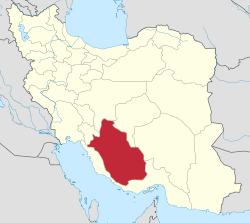Neyriz
| Neyriz نیریز | |
|---|---|
| city | |
 Neyriz | |
| Coordinates: 29°11′56″N 54°19′40″E / 29.19889°N 54.32778°ECoordinates: 29°11′56″N 54°19′40″E / 29.19889°N 54.32778°E | |
| Country |
|
| Province | Fars |
| County | Neyriz |
| Bakhsh | Central |
| Population (2006) | |
| • Total | 45,180 |
| Time zone | IRST (UTC+3:30) |
| • Summer (DST) | IRDT (UTC+4:30) |
Neyriz (Persian: نیریز, also Romanized as Neyrīz and Nīrīz)[1] is the capital city of Neyriz County, Fars Province, Iran. At the 2006 census, its population was 45,180, with 11,970 families.[2]
The name is also used for the district in which it is situated and for the Bakhtegan Lake. The town was located on its shores, but because of the shrinkage of the salt lake it is now to its southeast. In the nineteenth century some of the Neyriz inhabitants were Bábís, and were persecuted by the government.
The first name of this city was "Naizi"
Attractions
Friday mosque
The Friday mosque of Neyriz was built in at least three phases, spanning Buyid, Seljuk and Il-Khanid rule in the Fars province. An inscription on the great qibla iwan indicates that the mihrab was built in 973, which is probably the date when the qibla iwan and the minaret were constructed and enclosed within the precinct walls. Identified as "iwan-mosque," the pre-Islamic typology of the Masjid-i Jami' in Neyriz, Bamiyan and Nishapur has led some scholars to believe that their mihrabs and minarets may have been appended to Zoroastrian fire temples. At Neyriz, the northwest iwan facing the original sanctuary was erected at a later date, followed by the addition of two rows of lateral arcades along the courtyard and iwan walls. The portal, which bears the date 1472, commemorates the last known period of construction.
The mosque has a rectangular layout, measuring about forty-eight by thirty-four metres on the exterior. It is aligned with qibla along the northwest-southeast axis and is centred on an arcaded courtyard that is fifteen metres long and eighteen and a half metres wide. Entered from a simple portal at the northern end of the northwest façade, the courtyard is dominated by the tall sanctuary iwan that occupies its southwest wing. Eleven metres wide and seventeen metres deep, the sanctuary iwan is vaulted at a height double that of the flat-roofed courtyard arcades that continue along its side walls. The archways connecting the iwan to the arcades were pierced when the latter were constructed. The sanctuary iwan also dominates the exterior appearance of the mosque with its projecting buttresses.
Across the courtyard from the sanctuary is the vaulted northeast iwan, which is seven metres square. It is flanked by passageways on either side that connect it with the main portal and the secondary portal, which was added to the eastern corner of the mosque in 1472. It is adjoined by the modern addition of two halls that span the length of the southeast mosque wall; the southern of these halls contains ablution fountains and latrines. There's also an octagonal fountain at the center of the courtyard. A single minaret, with a round tapering shaft terminating at a parapet, rises alongside the main portal. The spiraling steps of the minaret are accessed from the northwest arcade.
The mosque is made of baked bricks, covered with clay on the exterior and plastered white on the interior. The courtyard façade of the great iwan is simply ornamented with polychrome tiles composed into geometric patterns. Inside, the decorative effort is focused on the mihrab niche on the qibla wall, which is framed with multiple bands of ornate arabesques and inscriptions carved in relief out of stucco. The original minbar, probably wooden, has since been replaced.[3]
Palangan
Palangan is a valley located in the south of the city, separated by a mountain. From the city center, Palangan is a 45 to 60 minutes trip. The valley is especially popular in spring and summer and is a wonderful promenade for people who live in this part of the world, especially during the 13 be-dar ceremony.
Palangan means "panthers"; in the past, many Iranian tigers lived in the region, but today only a few remain. The spring of the stream that flows through the valley is named Besher and is located two hours from Palangan.
References
- ↑ Neyriz can be found at GEOnet Names Server, at this link, by opening the Advanced Search box, entering "-3076911" in the "Unique Feature Id" form, and clicking on "Search Database".
- ↑ "Census of the Islamic Republic of Iran, 1385 (2006)". Islamic Republic of Iran. Archived from the original (Excel) on 2011-11-11.
- ↑ Friday mosque in Neyriz
![]() This article incorporates text from a publication now in the public domain: Chisholm, Hugh, ed. (1911). "article name needed". Encyclopædia Britannica (11th ed.). Cambridge University Press.
This article incorporates text from a publication now in the public domain: Chisholm, Hugh, ed. (1911). "article name needed". Encyclopædia Britannica (11th ed.). Cambridge University Press.
